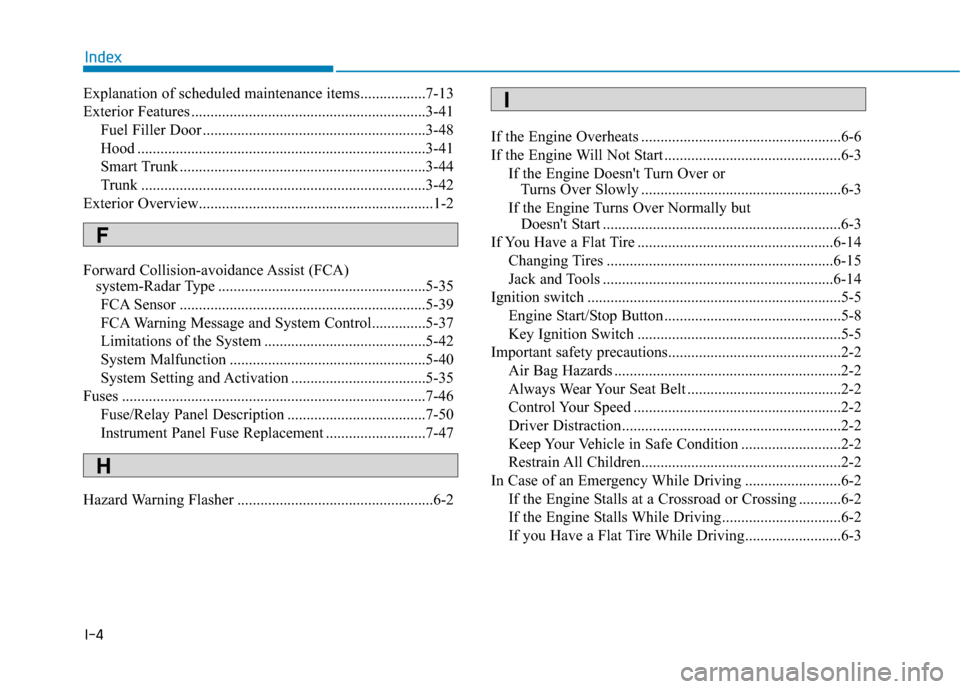sensor Hyundai Accent 2018 Owner's Guide
[x] Cancel search | Manufacturer: HYUNDAI, Model Year: 2018, Model line: Accent, Model: Hyundai Accent 2018Pages: 442, PDF Size: 13.99 MB
Page 398 of 442

7-59
7
Maintenance
Fuse NameFuse RatingCircuit Protected
FUEL PUMP20AE/R Junction Block (Fuel Pump Relay)
HORN10AE/R Junction Block (Horn Relay)
A/C10ASub Relay Block (A/C Relay)
AMS10ABattery Sensor
B+340AI/P Junction Block (Fuse - T/SIGNAL LAMP, DOOR LOCK, Tail Lamp Relay)
IG140AIgnition Switch, PDM Relay Box (IG1 Relay, ACC Relay)
POWER OUTLET40AI/P Junction Block (Power Outlet Relay)
Page 411 of 442

7-72
Maintenance
A
AP
PP
PE
EA
A R
RA
A N
N C
CE
E
C
C A
A R
RE
E
Exterior Care
Exterior general caution
It is very important to follow the label
directions when using any chemical
cleaner or polish. Read all warning
and caution statements that appear
on the label.
High-pressure washing
When using high-pressure wash-
ers, make sure to maintain suffi-
cient distance from the vehicle.
Insufficient clearance or excessive
pressure can lead to component
damage or water penetration.
Do not spray the camera, sensors or its surrounding area directly with
a high pressure washer. Shock
applied from high pressure water
may cause the device to not oper-
ate normally.
Do not bring the nozzle tip close to boots (rubber or plastic covers)or
connectors as they may be dam-
aged if they come into contact with
high pressure water.
Do not use any high-pressure noz- zles, which induce either one-direct
water stream or water swirling.
Protecting your vehicle's finish
Washing
To help protect your vehicle’s finish
from rust and deterioration, wash it
thoroughly and frequently at least
once a month with lukewarm or cold
water.
If you use your vehicle for off-road
driving, you should wash it after each
off-road trip. Pay special attention to
the removal of any accumulation of
salt, dirt, mud, and other foreign
materials. Make sure the drain holes
in the lower edges of the doors and
rocker panels are kept clear and
clean.
Insects, tar, tree sap, bird droppings,
industrial pollution and similar
deposits can damage your vehicle’s
finish if not removed immediately.
Even prompt washing with plain
water may not completely remove all
these deposits. A mild soap, safe for
use on painted surfaces, should be
used.
After washing, rinse the vehicle thor-
oughly with lukewarm or cold water.
Do not allow soap to dry on the fin-
ish. Do not use strong soap, chemi-
cal detergents or hot water, and
do not wash the vehicle in direct
sunlight or when the body of the
vehicle is warm.
Be careful when washing the side windows of your vehicle.
Especially, with high-pressure
water, water may leak through
the windows and wet the interi-
or.
To prevent damage to the plastic parts, do not clean with chemi-
cal solvents or strong deter-
gents.
NOTICE
After washing the vehicle, test
the brakes while driving slowly
to see if they have been affected
by water before getting on the
road. If braking performance is
impaired, dry the brakes by
applying them lightly while
maintaining a slow forward
speed.
WARNING
Page 438 of 442

I-4
Explanation of scheduled maintenance items.................7-13
Exterior Features .............................................................3-41Fuel Filler Door ..........................................................3-48
Hood ........................................................................\
...3-41
Smart Trunk ................................................................3-44
Trunk ........................................................................\
..3-42
Exterior Overview.............................................................1-2
Forward Collision-avoidance Assist (FCA) system-Radar Type ......................................................5-35
FCA Sensor ................................................................5-39
FCA Warning Message and System Control..............5-37
Limitations of the System ..........................................5-42
System Malfunction ...................................................5-40
System Setting and Activation ...................................5-35
Fuses ........................................................................\
.......7-46 Fuse/Relay Panel Description ....................................7-50
Instrument Panel Fuse Replacement ..........................7-47
Hazard Warning Flasher ...................................................6-2 If the Engine Overheats ....................................................6-6
If the Engine Will Not Start ..............................................6-3
If the Engine Doesn't Turn Over or Turns Over Slowly ....................................................6-3
If the Engine Turns Over Normally but Doesn't Start ..............................................................6-3
If You Have a Flat Tire ...................................................6-14 Changing Tires ...........................................................6-15
Jack and Tools ............................................................6-14
Ignition switch ..................................................................5-5 Engine Start/Stop Button ..............................................5-8
Key Ignition Switch .....................................................5-5
Important safety precautions.............................................2-2 Air Bag Hazards ...........................................................2-2
Always Wear Your Seat Belt ........................................2-2
Control Your Speed ......................................................2-2
Driver Distraction.........................................................2-2
Keep Your Vehicle in Safe Condition ..........................2-2
Restrain All Children....................................................2-2
In Case of an Emergency While Driving .........................6-2 If the Engine Stalls at a Crossroad or Crossing ...........6-2
If the Engine Stalls While Driving...............................6-2
If you Have a Flat Tire While Driving.........................6-3
Index
F
I
H